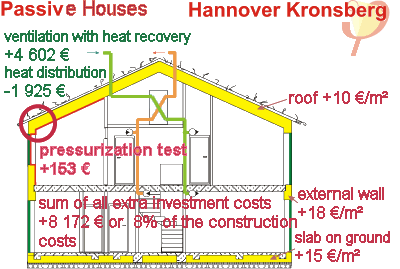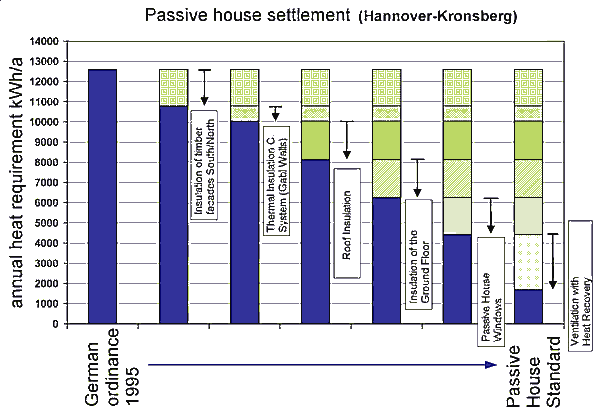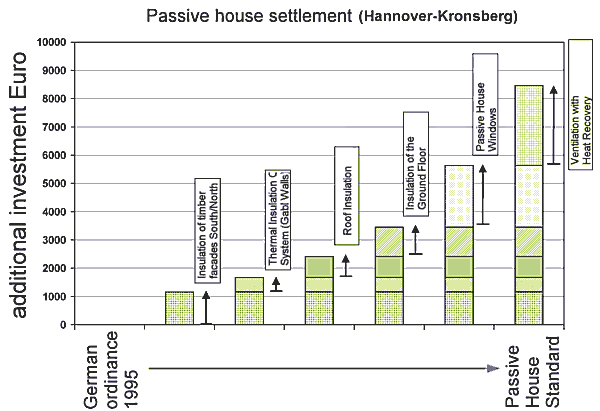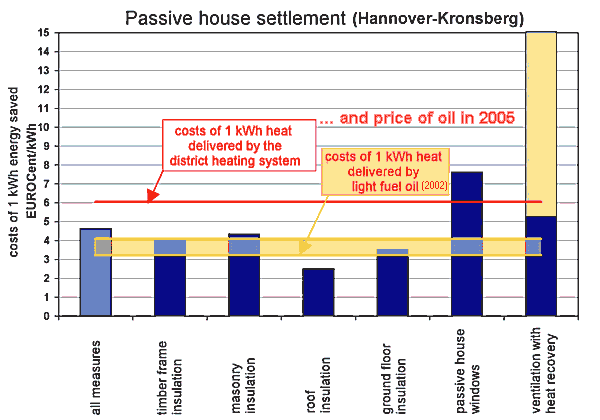| |
Step
by Step Towards Passive Houses |
|
|
Fig.1:
Section through the Passive Houses of the Hannover
Kronsberg settlement. In the figure the improvements compared to
average construction are highlighted.
A comprehensive documentation is available on the Passive Houses settlement at Hannover for free (download Passive House settlement Kronsberg (pdf 4.5 MB)). PHPP: The Passive House design (planning) package is a tool for design of Passive Houses. The energy balance is a major part of this tool. You find additional informations here: PHPP-page. |
| Passive Houses do not need a completely different construction method. In fact, all new construction can be realized in Passive House standard as well. It is a series of small steps, each resulting in a better quality of one component, which will lead beginning with an average new construction to a passive house. This will be illustrated using an example: The Passive House settlement
"Lummerlund" sited at the Kronsberg-site in Hannover has
been an important guiding project in the European demonstration
project CEPHEUS
(fig. 1). These houses are ordinary
row houses with tilted roofs. Extrinsicly they do not differ from
ordinary new construction. But they are passive houses - the differences
are small improvements in the details of the construction: more
insulation, better windows, high
air tightness and a heat recovery
from exhaust air. These measures result in a reduced heat requirement, see fig. 3. Step by step the better efficiency reduces the heat demand. In the end, the improvements add up to a consumption that is less than one seventh of the original one. One may follow the improvement of the energy balance in the animation, too. All steps do not change the character of the building: It stays an ordinary single family house. The only thing changed is the requirement for heating energy, but that is changed manifestly. By the way - the consumptions measured in the realised settlement very well coincide with the requirements calculated. The energy savings are actually realized. The extra costs for better construction and better HVAC-systems pay off. The investment costs broken down to "one Kilowatthour" (kWh) energy saved are shown in fig. 5. For insulation these are between 2,5 and 4,5 Cent each kWh. Already in 2001 the costs of the purchased heating energy were higher - and nowadays, in 2005, heat from heating oil costs some 6 Cent each kWh. The heat recovery ammounts to some 5 Cent, the Passivs House windows deliver "Saved Energy" by 7,5 Cent each kWh - but to realize a Passive House, the windows are needed, anyhow. All measures together result in 5 Cent/kWh - and that is definitly lower than the contemporary costs of energy on the market. These Passive Houses pay off - and so far we did not take into acount the extra benefits like good indoor air quality and extraordinary good thermal comfort. The energy sources of the future will be even more expensive - that holds for wind, solar and biomass energy. It makes sense, to utilize these renewable sources - at the other hand, it makes sense to utilize the improved efficiency as well, like it can be done with Passive Houses. A comprehensive documentation
is available on the Passive Houses settlement for free download:
Passive
Houses Kronsberg ( Fig .5: The economy of the measures: The investment costs for each single measure (fig .4) and the energy saved by the measure (fig. 3) are known, as well as the life cycle. From this the equivalent costs of a kWh saved energy by each measure have been calculated (including interest). Passive Houses pay back, already with contemporary energy prices. This is a link to the basic facts about Passive Houses. (updated:
2006-09-23 |




